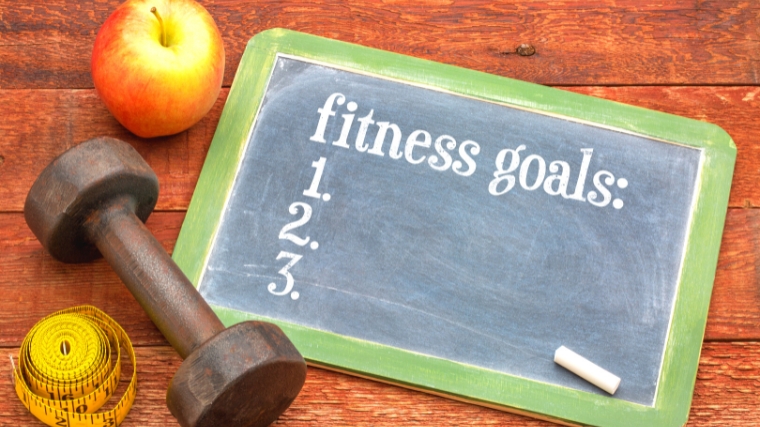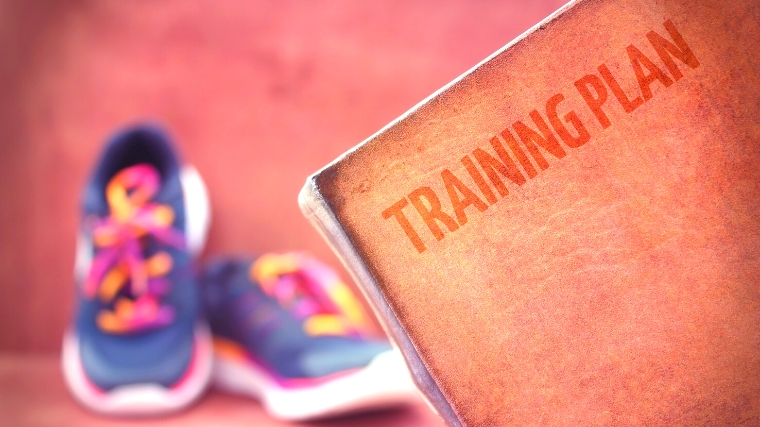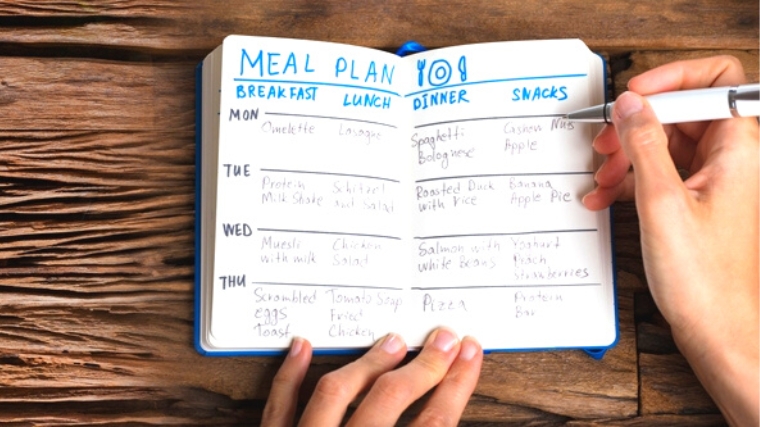Have you invested hours at the gym hoping to look like the Hulk, but the only growth you have seen is in your ponytail or beard? Even though you might be eager to have raised veins sprawling through your forearms, a chiseled core, and a muscular neck, your path there can feel a bit unclear.

For a beginner or an elite athlete in the gym, setting a specific fitness goal is crucial to hitting any strength milestone, achieving a specific physique, and mastering a barbell technique. Forging solid goals can also help you stay consistent in the gym while reaping the mental clarity and discipline you might be seeking from exercise.
A fitness goal establishes a standard you aim to meet while adding a motive behind your set and rep scheme. These goals will help you select the right training program for you, which is key to your success. Here’s how to create a fitness goal and stick to it.
How to Create a Fitness Goal
Fitness Goal Basics
A fitness goal is a specific training objective or physical challenge you set for yourself. In order to set a successful fitness goal, you need to specify what you want to obtain. Make the fitness goal measurable, within your range of abilities, and able to be done within a predetermined period of time. Customize it to your circumstances so you feel connected to it and more likely to crush it.
Setting a fitness goal includes self-awareness and action to create a projected outcome you can snatch. Over the course of chasing your goal, your abilities will ideally increase — you’ll get stronger, for example, as you march toward your first single-legged squat. But if you can’t even do a lunge on Monday, aiming to do your first pistol squat by next week isn’t all that realistic.
Accomplishing a fitness goal that is manageable, versus failing one outside of your limits, should ignite additional goals. You’ve improved your bench press — now it’s time to focus on that overhead press, for example. Over time, you will progress toward your long-term goals while gaining confidence by ticking short-term goals off your list.
How to Determine Your Fitness Goal
It’s easy to say you want to increase your strength. It’s harder to say how you will measure that strength — and what kind of strength you’re looking for. Here, you’ll learn how to set a fitness goal that will lend itself to a customizable training program for maximum results.
Make the Fitness Goal Specific
The first step to deciding your fitness goal is to specify what you want. The more particular your fitness goal, the easier it will be to find the right tools, routine, and exercises to conquer it.
For example, you might want to compete in your first powerlifting meet. You might decide to set a goal for a PR (personal record) you want to achieve in one, two, or all three of your lifts. That will help you customize your training accordingly with a program of progressive overload that will make it reasonable to achieve your goal numbers.
Find the Why Behind Your Fitness Goal
You might be trying to set a PR in a specific Crossfit event to satisfy your competitive edge. Or you’re looking to conquer an Atlas stone load for the first time.
Whatever your fitness goal, think through all of the logistical, physical, and emotional reasons that you want to achieve it. Consider writing down your reasons and motivations to block any urge to quit when you are exhausted or hit by unpredictable life events.
While it’s okay to have fitness goals for fun, fitness goals with deeper underlying motivations may be easier to stick with in the long run.
Record Your Starting Point
In order to move forward with a fitness goal, you have to mark your starting point to accurately evaluate your progress in the future. Experienced athletes and individuals ready to learn a strength sport for the first time may also want to record their starting point in relation to the new goal.
If you want to be a bodybuilder, for example, you may want to jot down your current measurements, macronutrient intake and other nutrition habits, and current body fat percentage. When progress feels slow, you can use hard facts to prove that you are in fact making more advancements than it seems. Or, you can investigate the reason for your plateau.
CrossFitters may choose to perform benchmark workouts related to their goal. If you know what your starting time is with Murph, you can track exactly how much better you’re getting at it along the way.
Whether you’re tracking workout speed, weight plates on the bar, or calorie intake, use your starting numbers to inform what you want those numbers to become. Start to scaffold out a reasonable timeline to meet those figures. Make sure to account for any time you know you might not be able to train as hard as usual (traveling or family plans, for example).
Make a Fitness Plan
You have an idea of your goals. Now, you need a way to get there. A training program is a scaffolded way to achieve your fitness goals over a given period of time. In a well-designed program, you’ll find the exercises, loads, and set and rep schemes you need to start making progress.
Pick a training program with a method that aligns with your fitness goal. For example, if you’re trying to build muscle, your program can certainly incorporate running — but you want the bulk of the program to be focused on lifting weights for hypertrophy.
Generally speaking, your program will incorporate various compound and isolation exercises with dedicated rest days to work all your muscles throughout the week. The amount of weight, number of reps, and muscles targeted will differ depending on the sport you’re training for.
For example, a training program for a bodybuilder and powerlifter may use similar methods such as progressive overload to increase muscle mass. But a powerlifter’s program will be focused on building overall strength in the big three — the squat, bench press, and deadlift — while a bodybuilder will focus more on hypertrophy than strength alone.
To ensure your time and effort in the gym are being used strategically to advance toward your goal and maximum strength, check out these options to help create the best plan.
Build Your Own Workout Program
In some cases, having an in-person or online coach can be beneficial — especially if you’re training for competition. You can also build your own workout program or select a classic program to train with.
Any training program you design will need to begin with you lifting at your current experience level and progressively get more challenging from there. Here are some resources to help you get started on building a workout program based on your goals:
- Everything You Need to Know to Build Your First Workout Program
- The Ultimate Guide to Building Your Own Bodybuilding Workout Plan
- How To Build Your Own CrossFit WOD, Regardless Of Your Experience Level
Once you’ve designed or selected your training program, make it a consistent habit and do your best to stick with it.
Train With a Coach or Training Buddy
For beginners and those who compete in strength sports, a highly-qualified coach is a great way to ensure you learn all of the ins and outs safely while optimizing your time.
One of the biggest components of strength sports is form. It can be hard to unlearn bad habits if you are accustomed to or start off performing exercises wrong. An expert can point out the flaws in your form and demonstrate ways to tweak what is holding you back.
In addition to learning proper technique, having a designated spotter you trust — especially if adding heavier weight is part of your fitness plan — may give you the confidence and safety you need to go for a PR.
You may be more likely to avoid an injury and lift powerfully with a strong workout partner following your lifts who is able to help out with techniques and missed lifts on the spot.
Follow Through
Choosing to work toward a fitness goal without a set of directions is like finding a destination without GPS – you could bump into the place you are looking for, but you are more likely to burn through a lot of gas and give up.
[Read More: Powerbuilding Workout Routine, With Tips from a CPT]
Do your best to stick with your plan, but don’t throw it all out the window if you veer a little bit off course. That said, if you miss a day — or even a week — there’s no need to start from scratch. Keep at it, even with the curve balls life might throw at you.
Remember that most programs need several weeks or even months to work. Try to avoid program hopping if you’re not seeing results within a week or two.
Food for Fuel
To get the most out of your fitness plan, you also have to focus on what goes into your body to fuel your exercises. No matter which strength sport you train for, you will need to maintain a combination of carbohydrates, protein, fats, micronutrients, and lots of water.
You’ll need various amounts of all of these before, during, and after your workouts. Each are essential for both in the gym performance and outside recovery.
If you have nutrition or physique goals — or if you’re just looking to support your training goals — your food plans will look different from sport to sport. From bulking to cutting, there is a science to enhance every performance goal.
Protein Intake Calculator
You might have heard rumors about the importance of protein in reaching your strength and muscle-building goals. The rumors aren’t untrue. As a strength athlete, you will likely want to increase your focus on protein in your diet.
To help you figure out exactly what that means, you can use BarBend’s protein intake calculator.
Protein Intake Calculator
While this calculator isn’t a personalized nutritionist, it can help give you a rough starting point for how to get where you’re going. To help customize the results, you’ll input information like your age, gender, goals, and activity level. (While only two genders are available in the calculator, there is ongoing research as to the nutritional needs of transgender and nonbinary strength athletes.)
Macro Calculator
Whatever your goals are, BarBend’s macronutrient calculator will help you figure out how much protein, carbs, and fats you need to fuel your goals. This is tremendously important for keeping you on track, especially if your goals are related to your physique.
Macronutrient Calculator
As with the protein intake calculator, you’ll have to input your activity level and goals. Make sure you’re realistic about your activity level when using the calculator for best results.
Discipline Delivers Dreams
Forming a consistent strength training routine is tough enough as it is — things like childcare, work, travel, and other personal interests, hobbies, and needs may often conflict with your gym schedule. That’s why it’s so important to go into a fitness routine with a clear goal in mind.
The clearer your goal is, the stronger your motivation is likely to be. Keeping focused on your goal may well help you get closer to performing the clean & jerk of your dreams.
Featured Image: GaudiLab / Shutterstock









